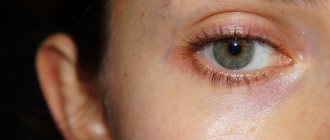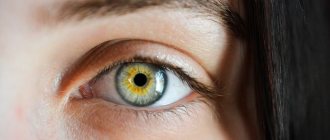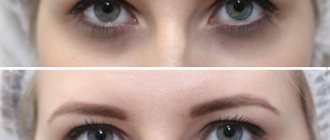06.03.2020
Blepharoplasty is a surgical operation that corrects the shape of the eyelids and the shape of the eyes. The surgeon removes areas of skin, fat layer of the lower and upper eyelids, providing a tightening effect.
The skin in this area ages first and the eyelid droops due to loss of elasticity. After 30 years, subcutaneous fat tissue also undergoes dystrophic changes - it grows and begins to sag. The look becomes tired and expressionless.
Therefore, women and men aged 40–45 who want to eliminate these cosmetic defects most often apply for blepharoplasty. By lifting the skin, the look becomes more open and the face appears younger.
Aesthetic indications for blepharoplasty
Blepharoplasty solves the following problems:
- excessive sagging of the skin of the upper eyelid;
- hernias of the lower eyelids - so-called bags under the eyes. This is a layer of fatty tissue accumulated in one place. Due to age or genetics, connective tissue septa cease to hold the lipid layer, and it begins to bulge;
- drooping corners of the eyes;
- eye asymmetry;
- sprain of the orbicularis oculi muscle;
- blepharochalasis - skin atrophy, as a result of which small wrinkled folds form above the eyelid;
- exophthalmos - excessive protrusion of the eyeball, bulging eyes;
- epicanthus - an additional fold at the inner corner of the eyelid (“Mongolian fold”).
If necessary, the plastic surgeon can slightly change the shape of the eyes.
What do experts think?
Bytdaev Zaur Makhrovich, plastic surgeon, candidate of medical sciences:
In my practice, after the recovery period there was no such problem, but immediately after the operation it can appear due to varying degrees of swelling. In order to get rid of this condition as quickly as possible, there is a list of measures that can effectively resolve the issue, including physical therapy. True, it is necessary to take into account that there is a congenital asymmetry, which is actually visible, but it can also be corrected.
Eye size difference
During the first month after surgery, differences in eye size can be considered normal. In order for everything to go smoothly, you need to strictly follow the surgeon’s recommendations and go for repeated examinations, since the doctor must monitor the rehabilitation process. If, upon completion of rehabilitation, no positive dynamics are observed, then this is considered a complication.
The first thing a patient should do in such a situation is to go to his surgeon to identify the causes and find a solution. Repeat blepharoplasty, canthoplasty, and other types of surgery may be necessary.
Aleksanyan Tigran Albertovich, plastic surgeon, candidate of medical sciences:
Eyes of different sizes occur when the operation is performed incorrectly or when the face is very uneven. I believe that first you need to choose the right surgeon, who has been performing such operations for a long time and knows how to do it, so as not to encounter unpleasant consequences in the end. Otherwise, you will have to do a second operation, which makes correcting the consequences much more difficult.
Levin Sergey Lvovich, plastic surgeon, Doctor of Medical Sciences:
Usually, in any person, the eyeball is more recessed on one side, and more protruding on the other and visually appears larger - this is a normal phenomenon. After upper eyelid surgery, the difference sometimes becomes more noticeable.
Another main factor is that after the operation the patient examines himself longer and more closely in front of the mirror and finds that asymmetry that he did not notice before. A less pleasant option is that if too much skin around the eyes has been excised, then the difference in the depth of their seating may be increased. And it can't be fixed.
Egorova Maria Vladimirovna, chief plastic surgeon at Frau Klinik:
Initially, the human skull as a whole and the eyes are asymmetrical. But almost no patient notices this. After surgery, a difference may occur due to close attention to the area as well as swelling. In general, recovery lasts 6 months; during this time, various complaints may arise regarding the operated area, which does not require additional intervention.
Different eyes are a complication if asymmetry was obtained due to incorrectly performed blepharoplasty. In some situations, correction is possible, but its feasibility can only be determined during a face-to-face consultation with a surgeon.
YouTube responded with an error: The request cannot be completed because you have exceeded your quota.
Rate this article:
- Related Posts
- Why do my eyes itch after blepharoplasty?
- Is blepharoplasty dangerous?
- Can hollows form under the eyes after blepharoplasty?
- How to remove seals on the lower eyelid after blepharoplasty?
- In what cases is Diprospan needed after blepharoplasty?
- How do scars heal after blepharoplasty?
Medical indications for blepharoplasty
An ophthalmologist will send you for reconstructive blepharoplasty if it is determined that the structure of the eyelids interferes with the functioning of the visual apparatus. Indications may be:
- ptosis of the upper eyelid - its abnormally low location;
- severe narrowing of peripheral vision due to excessive overhang of skin folds;
- entropion - inversion of the eyelid, when the eyelashes and its edge are turned towards the eyeball;
- ectropion - inversion of the tissues of the lower and upper eyelids outward.
Blepharoplasty has moved into the arsenal of plastic surgeons from ophthalmology, where similar interventions were carried out back in the century before last. However, modern technologies have made it possible to classify blepharoplasty as a one-day operation: after it, the patient can return home the next day.
Causes of eyelid asymmetry
The situation when during the first weeks and even months after blepharoplasty one eye is wider and the other is narrower is a fairly common occurrence. Behind the external manifestation of the problem there may be a whole list of reversible and irreversible changes in tissues. The main and most common cause of asymmetry of the palpebral fissures is postoperative swelling. When performing eyelid surgery, they are quite stable and can resolve within six months, sometimes longer.
Uneven accumulation of fluid in the area of the right and left eyes almost always leads to the fact that either the eyelids will be at different heights, or their shape will be deformed, or the incision on one side will be narrower than on the other. But as the swelling subsides, the eyes will also return to normal, and the problem will resolve itself. More serious causes that may require additional corrective procedures and sometimes reoperation:
- formation of persistent ptosis of the upper eyelids. Due to severe swelling, ptosis is present to any degree in the first months of recovery, but normally it should gradually go away. Alas, sometimes this does not happen completely, and if ptosis still persists within 6 months after the operation, it will not go away on its own, it needs to be removed;
- uneven facial expressions, when the muscles on one side are more developed than on the other - this feature could have been present for a long time and became obvious after surgery or developed already during the rehabilitation period;
- uneven structure of the facial part of the skull, and this applies to soft tissues and bone structures. In this situation, a small difference in the size or shape of the eyes was likely visible before surgery, but became much more noticeable after surgery;
- creating rough scars that strongly tighten the tissues of the eyelids or change the shape of the palpebral fissure. It is noteworthy that the small, barely visible difference between the heights of the upper eyelid folds may be related to which hand the surgeon has the dominant hand. Corrections make a slightly less neat cut on the left side, and vice versa - but if the scars are healed without complications, outwardly everything will look perfectly smooth;
- errors by the surgeon at the time of preparation and performance of the operation: removal of too much or insufficient amount of skin, injury to muscle fibers or tendons, incorrect suturing.
We recommend: What to do if your eyes are pulled after blepharoplasty?
Before and after surgery: photos
Types of blepharoplasty
Tell the surgeon in detail about your expectations from permanent blepharoplasty - the doctor will take into account your anatomical features and select the optimal surgical technique. All classical technologies involve incisions with a surgical scalpel.
Upper or anchor blepharoplasty
Upper eyelid blepharoplasty is the most popular operation. Aimed at removing excess skin, fat or muscle in this area. An experienced VIP Academy surgeon will determine how much tissue needs to be excised so that the eyelids can close properly.
Lower, or subliciary, blepharoplasty
Blepharoplasty of the lower eyelid involves excision of fat bags under the eyes, and, if necessary, the skin stretched over them is removed. Sometimes the desired effect is achieved through the redistribution of fat depots.
Circular blepharoplasty
This is a simultaneous lift of the upper and lower eyelids. It takes place in several stages, lasts longer than other operations (up to 3 hours) and is considered more complex. The technique involves a highly qualified surgeon; the maximum number of defects is eliminated at a time.
Transconjunctival blepharoplasty
The surgeon can make an incision above the upper eyelashes, on the outside of the eyelid, or mini-punctures on the mucous membrane, on the inside. In the latter case, the technology is called transconjunctival. This type of blepharoplasty allows you to achieve a high aesthetic effect, since no stitches are needed at all, which means there will be no scars.
Sometimes eyelid blepharoplasty alone is not enough to correct the defect. It is combined with a surgical facelift in certain areas (frontal, superciliary, infraorbital, zygomatic or cheek areas).
From below, from above or in a circle?
There are different types of eyelid surgery. There are blepharoplasty:
- Lower eyelids. It is most popular among middle-aged women. Indicated for excess fat deposits in the depression of the lower eyelid and the presence of fatty hernias (that is, those same hated bags under the eyes). With age, the muscles weaken and the lower eyelid droops, which contributes to the accumulation of excess tissue. During the operation, the surgeon makes an incision along the edge of the lower eyelid, which subsequently makes the suture invisible.
Article on the topicDangerous “improvement”. The surgeon talks about whether you need to make sacrifices for the sake of beauty
- Upper eyelids. It is performed for drooping of the upper eyelid (blepharochalasis). This defect can occur over the years, but it also occurs in young people. It is believed that blepharochalasis may be associated with endocrine and vascular disorders, neurotrophic disorders, genetic predisposition, inflammatory diseases of the eyelids, and others. If the overhang is slight, it’s not a problem, it can be regarded as an individual feature (after all, drooping eyelids didn’t stop Claudia Schiffer and Brigitte Bardot from becoming stars!). But if you wish, you can resort to upper eyelid surgery. The incision is made in the area of the natural crease of the upper eyelid, which makes it subsequently invisible. Along with the excision of excess skin, fat accumulations on the upper eyelid are also eliminated.
- Circular. This is a comprehensive correction of the lower and upper eyelids. Allows you to solve several problems at once, such as sagging upper eyelids, fatty hernias, bags. Postoperative stitches are also invisible, since the incisions are made under the lower eyelash line and in the natural crease of the upper eyelid. Often this operation is combined with laser resurfacing, which gives a more impressive effect.
- Transconjunctival. This is a modern and gentle technique for eliminating lower eyelid hernias, in which the incision passes directly through the conjunctiva, through which excess periorbital fatty tissue is removed. The operation takes place under local anesthesia and leaves no scars. With laser transconjunctival blepharoplasty, the rehabilitation period is shorter and the risk of complications is minimal.
- Ethnic. Plastic surgery of Asian eyelids is a jewelry work that requires impeccable knowledge and skills from the doctor. Changing the shape and shape of the eyes is achieved by forming a fold in the upper eyelid.
Chin up! The truth about rhinoplasty Read more
Examination before blepharoplasty
Before blepharoplasty, it is necessary to undergo an examination to determine contraindications to surgery. Mandatory manipulations include:
- general blood and urine tests,
- blood chemistry,
- coagulogram - test for blood clotting,
- tests for HIV, syphilis, hepatitis B and C,
- ECG.
At the VIP Academy, patients must be examined by an ophthalmologist, because blepharoplasty is contraindicated for keratitis, blepharitis, glaucoma, and cataracts.
How is the operation performed?
The surgeon will treat the eyelids with an antiseptic solution three times, then will delimit the surgical field from the surrounding tissues with sterile material.
Injections of local anesthetic are the only painful part during surgery. While the medicine is being administered, you will feel pain and swelling of the soft tissues of the eyelid. Unpleasant symptoms will be replaced by complete insensitivity within 1–3 minutes.
Upper blepharoplasty
The surgeon will mark the skin of the upper eyelids and mark the incision lines. In upper eyelid blepharoplasty, the tissue is cut 7–9 mm from its edge and excess skin is carefully excised.
Capillary bleeding is stopped with an electrocoagulator - a device for cauterizing damaged vessels. A competent surgeon begins suturing the wound only after the bleeding has sufficiently stopped. Sutures are placed on the upper eyelid with a thin atraumatic needle strictly along the incision line.
Lower blepharoplasty
In lower eyelid blepharoplasty, the incision is made at a distance of 2–3 mm from the ciliary edge.
The skin of the lower eyelid, together with the orbicularis oculi muscle, is carefully moved down a few millimeters, opening access to the hernial sacs. They are excised, after which the skin of the lower eyelids is returned to its original position.
The surgeon excises excess skin folds near the primary incision with a single linear flap.
The last stage of lower blepharoplasty is layer-by-layer suturing of the wound of the lower eyelids. The suture is placed intradermally to avoid scarring and poor alignment of the wound edges. Our surgeons apply cosmetic sutures using modern techniques and achieve high aesthetics.
Rehabilitation
If you neglect the doctor’s recommendations during this period, the surgeon’s efforts may be in vain, and you will not get the desired effect. At first you will have to endure the inconvenience and show discipline.
The first hours after surgery
Within 3 to 4 hours after surgery, the anesthesia will wear off and you will feel mild pain in the eyelid area. You may also be concerned about:
- increased sensitivity to light,
- numbness of areas of the eyelid,
- double vision,
- increased tearfulness.
To relieve symptoms, your doctor will prescribe nonsteroidal anti-inflammatory drugs (NSAIDs). They also have an analgesic effect.
First week after surgery
On days 2–3, swelling of the soft tissues of the eyelid increases. It goes away on its own 5–7 days after blepharoplasty. Excessive swelling will help prevent simple rules:
- exclude from your diet foods that retain moisture in the body - salted, fried and smoked foods;
- reduce the amount of liquid consumed;
- avoid tilting your head and torso;
- do not engage in sports or physical labor;
- Avoid eye strain while reading, working at a computer screen or other gadgets.
These restrictions are lifted within 10–14 days after blepharoplasty. Until the wound on the eyelid has completely healed, you should not use decorative and caring cosmetics - the products can cause an allergic reaction or inflammation.
Sutures from the wound are removed on days 7–9 of the rehabilitation period.
Deferred period
The late rehabilitation period begins 2–3 weeks after blepharoplasty. At this time, the structure of the skin is gradually restored:
- swelling goes away completely;
- redness in the suture area disappears;
- new collagen fibers are formed.
The postoperative scar on the eyelids becomes invisible 1–2 months after blepharoplasty. At this time, you can already use cosmetics, so minor redness can be easily masked.
What to do if you have eye asymmetry after blepharoplasty
Rehabilitation after eyelid correction is different for everyone, it depends on the complexity of the correction performed and the patient’s body. If you follow all the recommendations of your doctor, this period will pass quickly and painlessly. There is a certain algorithm of actions during the recovery period, which has been practiced in many clinics for many years. However, remember that each case is individual, and your doctor may make adjustments to the general recommendations.
The first 2 weeks after blepharoplasty
We strongly recommend that you do not look at yourself in the mirror immediately after surgery. The presence of edema can significantly spoil the mood and drive a weak-nervous patient to despair. Remember, this phenomenon is temporary, swelling tends to disappear slowly and unevenly. Pronounced bruises are also a common occurrence after blepharoplasty. Seams on the eyelids located at different levels can emphasize the asymmetry of the eyes. All these phenomena are not a reason to panic; you should be patient until the physiological changes take place naturally.
Factors that can cause uneven swelling:
- lifting weights;
- work in an inclined position;
- individual characteristics of the location of lymphatic vessels and veins, which are responsible for the outflow of excess fluid from tissues;
- uneven tissue injury, which contributes to the presence of greater swelling on one side of the face;
- sleeping on your side or back;
- failure to maintain drinking balance during the rehabilitation period
2-3 weeks after blepharoplasty, swelling begins to subside. In this case, the eyelids, ideally, should become even. However, the palpebral fissures will not immediately become symmetrical. If you observe a trend in which the right eye becomes similar to the left, the ridges and folds in the eyelid area are smoothed out, and excess water gradually disappears - the recovery process is proceeding normally, and there is no reason to panic. It is worth being as patient as possible and letting the rehabilitation process take its natural course.
div id=”content_rb_84609″ class=”content_rb” data-id=”84609″>
Possible complications
Most often, complications arise when the patient does not follow the doctor’s recommendations. But the surgical technique, the skill of the surgeon and the individual characteristics of the body are also of great importance.
What shouldn't scare you
Complications of blepharoplasty do not include pain and swelling - this is a physiological reaction of the body in response to trauma to the skin. After lower eyelid blepharoplasty, temporary lower eyelid separation is also possible. After 7–10 days, this phenomenon disappears, and the lower eyelid returns to its place.
What should you be wary of?
True postoperative complications include:
- hematoma formation - occurs if bleeding in the damaged tissues of the eyelid has not been sufficiently stopped;
- dry eye syndrome - tear production is impaired, the surface of the eye is not wetted by tear fluid;
- bacterial conjunctivitis;
- cysts on the suture lines;
- rough scarring of the wound - usually observed in patients prone to keloid formation. In them, any damage to the skin is accompanied by a violent reaction of the body in the form of proliferation of connective tissue.
Only some of the complications of blepharoplasty are considered to be surgical errors:
- violation of eye symmetry;
- eversion or drooping of the eyelid, incomplete closure - occurs when the surgical technique is violated, too large a musculocutaneous flap is excised;
- blindness is an extremely rare complication associated with the formation of a large hematoma in the retrobulbar space. Usually develops in the first hours after blepharoplasty
If you have any doubtful symptoms, contact your doctor immediately. The doctor will distinguish complications from the normal course of the postoperative period and prescribe therapy.
Options for correcting eyelid asymmetry after blepharoplasty
Any concerns or questions you may have regarding your surgical results should be addressed to your plastic surgeon, and their recommendations should be taken seriously. If you doubt the qualifications of the surgeon who performed your operation, you can consult another doctor.
It all depends on what causes the defect and how pronounced it is, so the appropriate method of correction is selected - from decorative cosmetics to repeated surgery. The most effective are:
- massage. Manual or hardware treatment of the face and eyelids helps restore muscle tone and accelerate the outflow of venous blood and lymph. This allows you to remove swelling, remove toxic decay products from the body, which occur in large quantities in damaged tissues, and provide an influx of oxygen and nutrients, which speeds up healing. It is important not to self-medicate, but to agree on the type of procedures and their frequency with the surgeon: a lot depends on the individual characteristics of the body and how the recovery period goes;
- microcurrent therapy. This physiotherapy procedure is most often used when you need to tone muscles and restore their activity. If blepharoplasty was performed, then this therapy will help if the difference in the size and width of the eyes is characterized by facial expressions or unsuccessful scarring, since currents resolve fibrous tissue;
- Botox. Botulinum toxin injections can improve the tone of facial wrinkles that move the eyelids of the right and left eyes. This is a good alternative to surgical lifting if the asymmetry is not pronounced and is characterized by different muscle activity on different sides of the face;
- reoperation. Alas, this is not such a rare thing among those who have once had blepharoplasty. Almost always allows you to solve problems caused by rough scarring and restore the smooth shape of the eye slits. It is much more difficult to correct defects associated with the removal of excess skin. Such an operation should only be trusted to professional surgeons, since the risk of new complications (non-closure or inversion of the eyelid, scars) increases. And the repeated intervention itself is technically more difficult than the first.
But before you think about correction and go under the surgeon’s knife, you need to determine for yourself whether the eye is actually uneven and the asymmetry is really visible to others, or whether the problem is psychological in nature, associated with inflated expectations and overestimation of the result.
We recommend: When is blepharoplasty considered unsuccessful?
Result and forecast
The intermediate effect of blepharoplasty can be judged 2–3 weeks after surgery. The final result is assessed 3–6 months later and lasts 8–12 years.
But the skin continues to lose its elastic properties, so sometimes it may be necessary to repeat eyelid blepharoplasty ahead of schedule. In older age groups, it is often combined with a surgical facelift.
A good final effect from blepharoplasty is the result of a constructive dialogue between the doctor and the patient, the doctor’s skill and the correct rehabilitation period.
Complication or not? The time it takes for the eyes to return to normal
The speed at which tissue recovery occurs after injury varies from person to person. There is a general rehabilitation scheme that has been tested in practice, which you can rely on and, in case of a pronounced deviation from it, consult with your doctor.
The first 10-14 days after surgery
At this time, it is better not to look at yourself in the mirror at all. Tissue swelling goes away slowly and unevenly. Bruises have a distinct color. the seams on the eyelids can be at different levels, once again showing differences in the size of the eyes. But all these troubles are not a physiological deviation. There is no reason to be upset: most likely, the reason is uneven swelling. Factors that contribute to its formation:
- sleeping on your side or back with your head turned to one side;
- anatomical features of the location of veins and lymphatic vessels, which characterizes different rates of outflow of excess fluid from tissues;
- uneven tissue injury, resulting in more swelling on one side;
- working in an inclined position and lifting heavy objects;
- non-compliance with doctor’s recommendations regarding drinking balance;
- time from 2 weeks to 2 months after eyelid lift.
At 2-3 weeks, swelling begins to rapidly resolve. This does not mean that the palpebral fissures will immediately achieve perfect symmetry. But normally, the eyelids should gradually become even. If the right eye becomes more and more similar to the left, excess water disappears, and there are no large folds or ridges on the skin around the eyes, then everything is fine, you just need to be patient and allow the tissues to recover as much as possible.
At the end of the second month, it becomes clear whether the asymmetry was caused by edema or other reasons that can lead to the formation of a long-term defect. If the result at this stage of rehabilitation is not satisfactory, you need to contact your doctor to:
- undergo diagnostics to identify more serious complications (symptoms of ptosis, problems with facial muscles);
- if all is well, get recommendations regarding eyelid care.
Usually, for quick healing, doctors prescribe manual and physical therapy procedures. But it is not recommended to massage your eyelids yourself or sign up for hardware cosmetology at a salon. Such independence may not produce results and even cause harm. It is better for the cosmetologist to work closely with your plastic surgeon, then the result will be positive.
Time from 2 to 6 months after plastic surgery
It is during this period that it becomes clear - either the surgical procedure was successful, or the eyes will remain different: one is wide, the other is narrow. The following phenomena are problematic:
- asymmetrical eye shape: for example, one is almond-shaped and the other is round, or one slit is much narrower than the other;
- the upper or lower eyelids are at different levels, or on one side the word is adjacent to the eyeball and does not open or close completely;
- the fold above the ciliary edge of the upper eyelid is deeper or much higher than on the other side;
- the eyes on one side look more puffy than on the other, there is deformation of the skin around it, which is not present on the eyelids on the opposite side;
- there are visible or palpable seals in the operated area;
- at rest, the eyelids are the same, but when smiling, a strong asymmetry is noticeable: on one side the size or shape of the eye changes, skin folds form.
We recommend: How to correct the round eye effect after blepharoplasty?
At the same time, any conclusions should be drawn no earlier than after 4-6 months. To assess a real defect, you need to take several photographs in different lighting and from different angles, experiment with decorative cosmetics and ask questions to loved ones who will give their objective assessment.
Eyelid surgery at VIP Academy is safe
Our medical center employs plastic surgeons and ophthalmological surgeons who have already performed more than 5,000 blepharoplasties. take into account the physiology of the entire appendage apparatus of the eyes: muscles, skin and cartilage tissue of the eyelid, subcutaneous tissue and conjunctiva. The doctor accurately determines the amount of intervention in order to achieve a good result and not disrupt the function of the visual organ.
We have a license from Roszdravnadzor to provide plastic surgery services.
Make an appointment with a surgeon by phone or through the website. The manager will answer additional questions via online chat.











